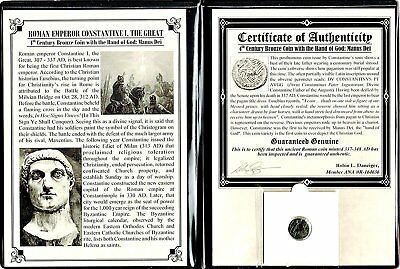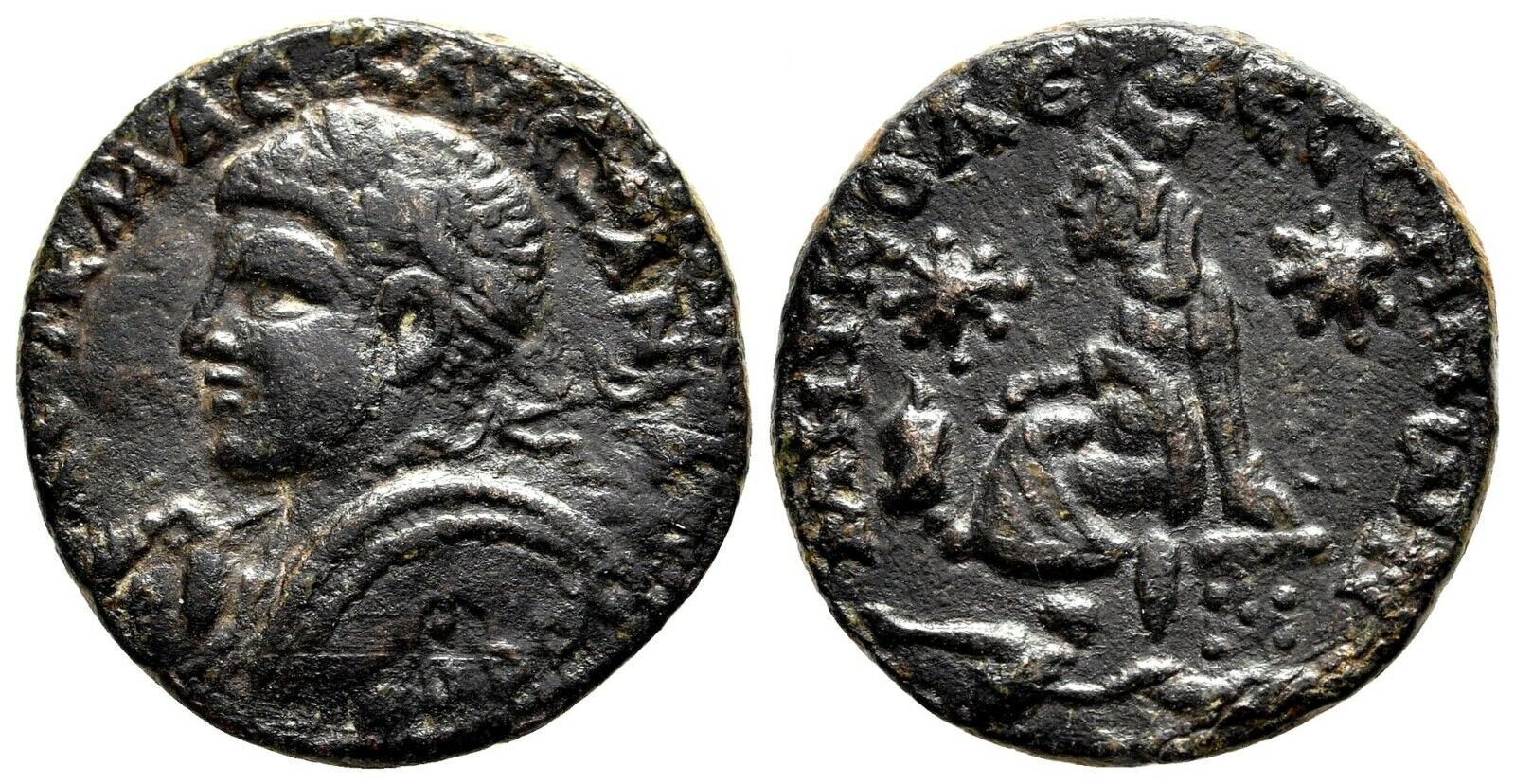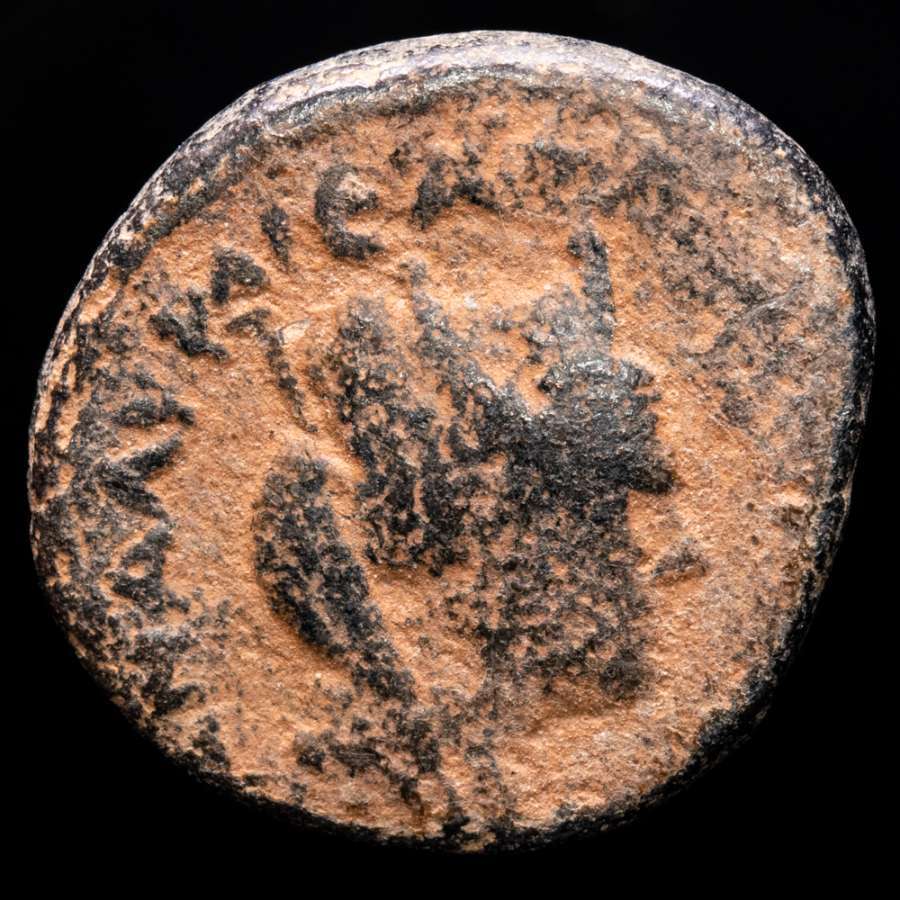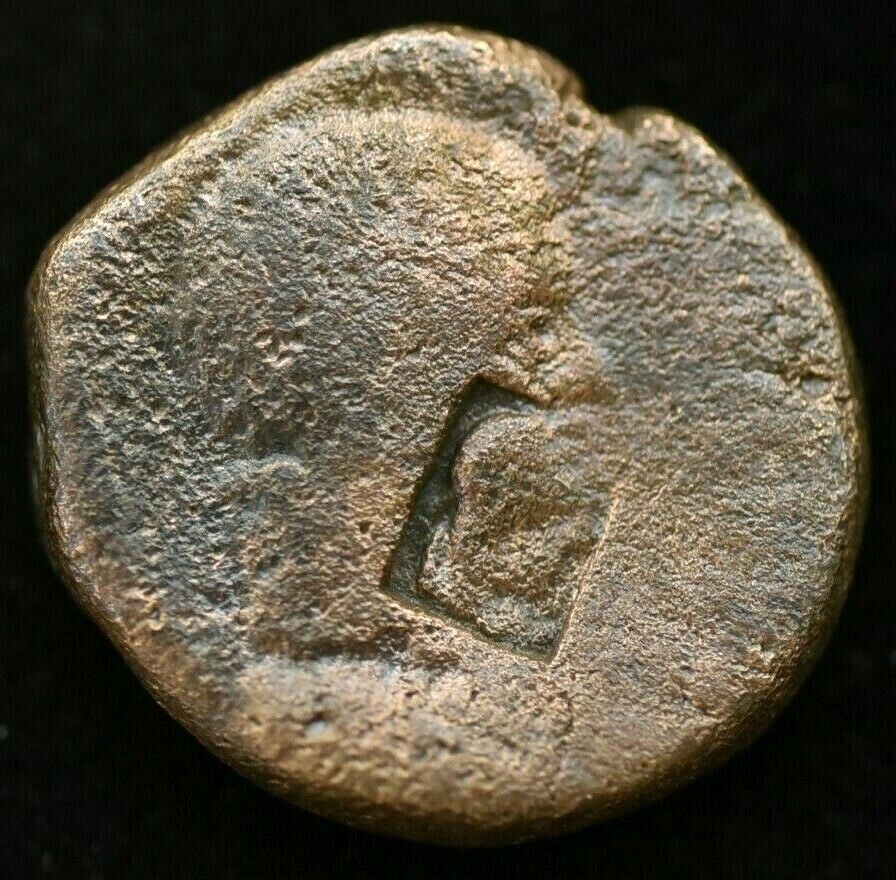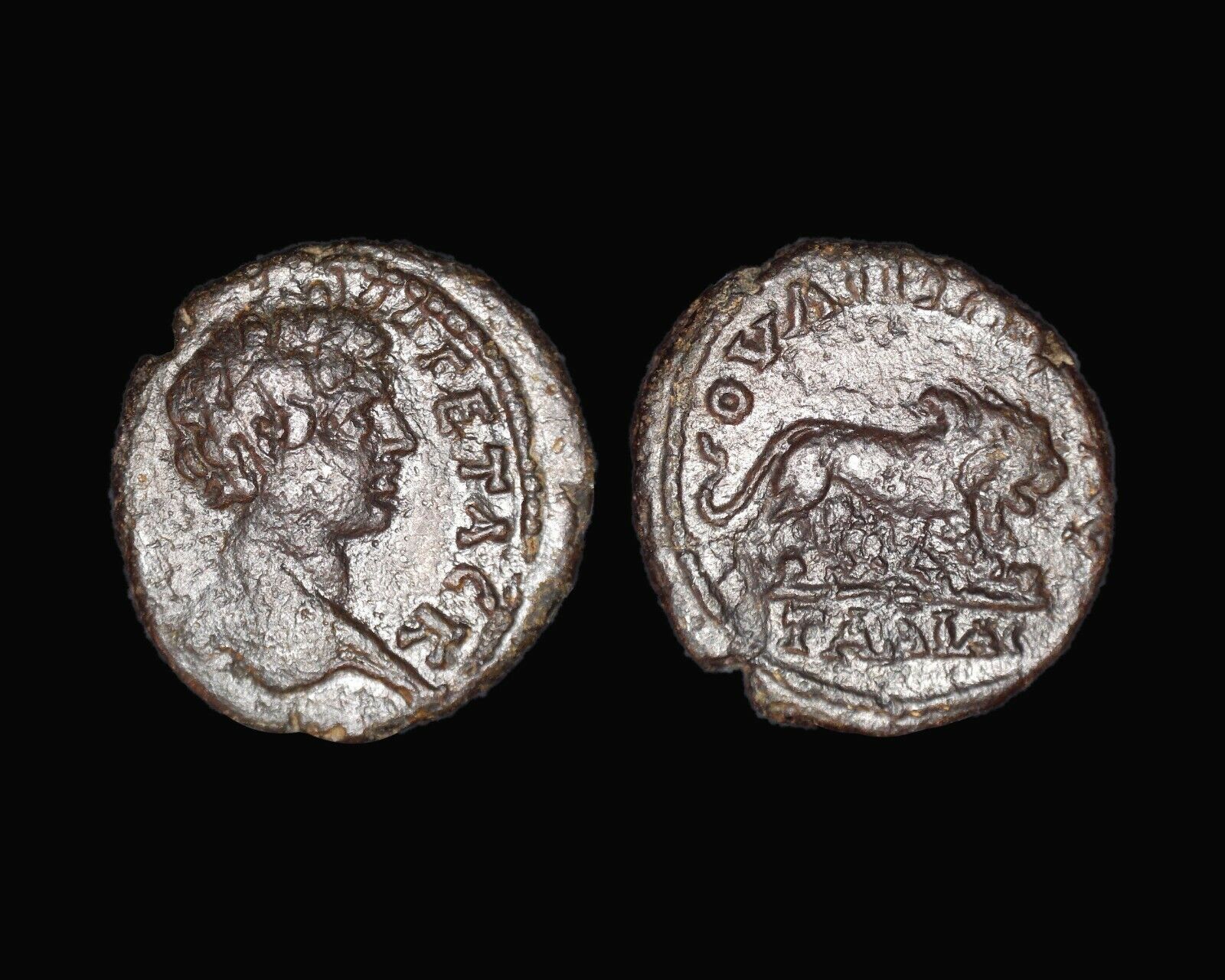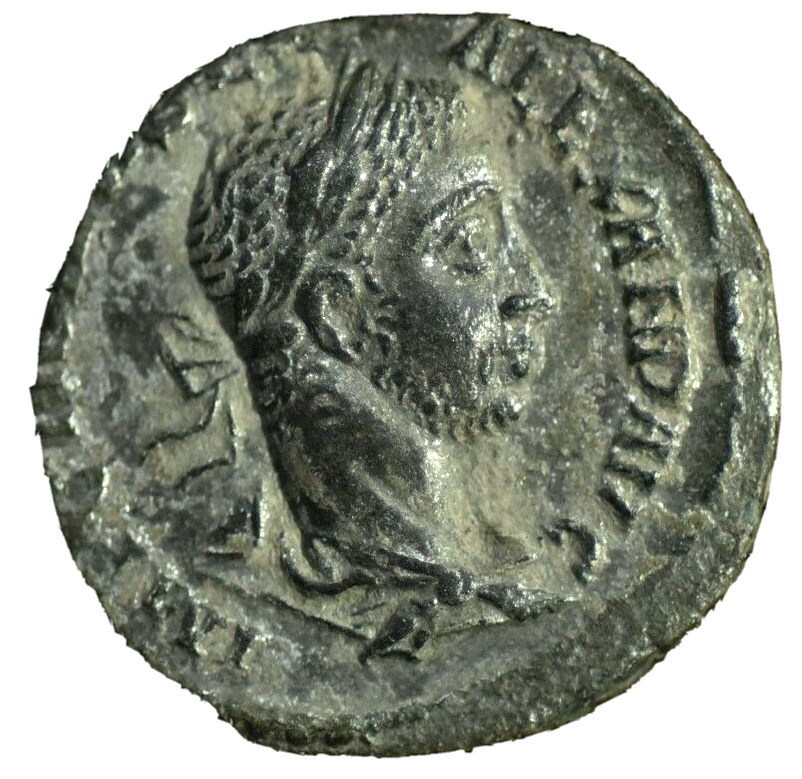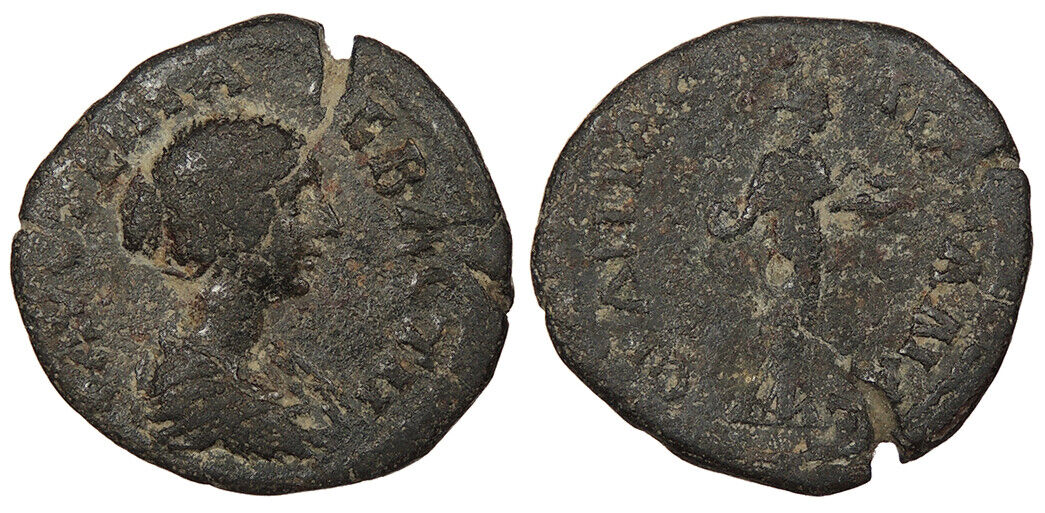-40%
GALLIENUS 267AD Alexandria Egypt Homonoia Authentic Ancient Roman Coin i55162
$ 137.28
- Description
- Size Guide
Description
Item:i55162
Authentic Ancient Coin of:
Gallienus - Roman Emperor: 253-268 A.D. -
Bronze 22mm (9.47 grams) of Alexandria in Egypt, Dated RY 15, 267/268 A.D.
Reference: Dattari 5247; Köln 2950; Milne 4165; Curtis 1605; Emmett 3816
ΑVΤ Κ Π ΛΙΚ ΓΑΛΛΙΗΝΟC CЄB, Laureate and cuirassed bust right.
Homonoia standing left, holding double cornucopia and raising hand; LIЄ (date) in field to left; palm in field to right.
<="" font="" face="Times New Roman">
You are bidding on the exact item pictured, provided with a Certificate of Authenticity and Lifetime Guarantee of Authenticity.
Homonoia was a minor goddess of concord, unanimity, and oneness of mind in classical
Greek
culture. Her opposite number was
Eris (Strife)
. She is associated with
Praxidike
the goddess of judicial
punishment
, the exacter of vengeance. Praxidike's daughters were
Arete
(a goddess personifying
virtue
) and
Harmonia
(the very spirit of concord). As such Homonoia was probably closely identified with the Theban Goddess-Queen
Harmonia
.
Alexandria was founded by
Alexander the Great
in April 331 BC as
Ἀλεξάνδρεια
(
Alexándreia
). Alexander's
chief architect
for the project was
Dinocrates
. Alexandria was intended to supersede
Naucratis
as a
Hellenistic
center in Egypt, and to be the link between Greece and the rich
Nile Valley
. An Egyptian city,
Rhakotis
, already existed on the shore, and later gave its name to Alexandria in the
Egyptian language
(Egyptian
*Raˁ-Ḳāṭit
, written
rˁ-ḳṭy.t
, 'That which is built up'). It continued to exist as the Egyptian quarter of the city. A few months after the foundation, Alexander left Egypt and never returned to his city. After Alexander's departure, his viceroy,
Cleomenes
, continued the expansion. Following a struggle with the other successors of Alexander, his general
Ptolemy
succeeded in bringing Alexander's body to Alexandria.
Alexandria, sphinx made of
pink granite
,
Ptolemaic
.
Heptastadion and the mainland quarters seem to have been primarily Ptolemaic work. Inheriting the trade of ruined
Tyre
and becoming the centre of the new commerce between Europe and the
Arabian
and Indian East, the city grew in less than a generation to be larger than
Carthage
. In a century, Alexandria had become the largest city in the world and, for some centuries more, was second only to Rome. It became Egypt's main Greek city, with
Greek people
from diverse backgrounds.
Alexandria was not only a centre of
Hellenism
, but was also home to the largest Jewish community in the world. The
Septuagint
, a Greek translation of the
Hebrew Bible
, was produced there. The early Ptolemies kept it in order and fostered the development of its museum into the leading Hellenistic center of learning (
Library of Alexandria
), but were careful to maintain the distinction of its population's three largest ethnicities: Greek, Jewish, and
Egyptian
. From this division arose much of the later turbulence, which began to manifest itself under
Ptolemy Philopater
who reigned from 221–204 BC. The reign of
Ptolemy VIII Physcon
from 144–116 BC was marked by purges and civil warfare..
The city passed formally under Roman jurisdiction in 80 BC, according to the will of
Ptolemy Alexander
, but only after it had been under Roman influence for more than a hundred years. It was captured by
Julius Caesar
in 47 BC during a Roman intervention in the domestic civil war between king
Ptolemy XIII
and his advisers, and the fabled queen
Cleopatra VII
. It was finally captured by
Octavian
, future
emperor
Augustus on 1 August 30 BC, with the name of the month later being changed to
August
to commemorate his victory.
Kitos War
, which gave
Hadrian
and his architect,
Decriannus
, an opportunity to rebuild it. In 215, the
emperor
Caracalla
visited the city and, because of some insulting
satires
that the inhabitants had directed at him, abruptly commanded his troops to
put to death
all youths capable of bearing arms. On 21 July 365, Alexandria was devastated by a
tsunami
(
365 Crete earthquake
), an event still annually commemorated 17 hundred years later as a "day of horror." In the late 4th century, persecution of
pagans
by newly Christian Romans had reached new levels of intensity. In 391, the Patriarch
Theophilus
destroyed all pagan temples in Alexandria under orders from Emperor
Theodosius I
. The
Brucheum
and Jewish quarters were desolate in the 5th century. On the mainland, life seemed to have centred in the vicinity of the
Serapeum
and
Caesareum
, both of which became
Christian churches
. The
Pharos
and
Heptastadium
quarters, however, remained populous and were left intact.
In 619, Alexandria
fell
to the
Sassanid Persians
. Although the
Byzantine Emperor
Heraclius
recovered it in 629, in 641 the Arabs under the general
Amr ibn al-As
captured it during the
Muslim conquest of Egypt
, after a siege that lasted 14 months.
="">
Gallienus
(
Latinin
:
Publius Licinius Egnatius Gallienus Augustus
; c. 218 – 268) was
Roman Emperor
with his father
Valerian
from 253 to 260 and alone from 260 to 268. He ruled during the
Crisis of the Third Century
that nearly caused the collapse of the empire. While he won a number of military victories, he was unable to prevent the secession of important provinces.
Life
Rise to power
The exact birth date of Gallienus is unknown. The Greek chronicler
John Malalas
and the
Epitome de Caesaribus
report that he was about 50 years old at the time of his death, meaning he was born around 218. He was the son of emperor
Valerian
and
Mariniana
, who may have been of senatorial rank, possibly the daughter of
Egnatius Victor Marinianus
, and his brother was
Valerianus Minor
. Inscriptions on coins connect him with
Falerii
in
Etruria
, which may have been his birthplace; it has yielded many inscriptions relating to his mother's family, the Egnatii.
[3]
Gallienus married
Cornelia Salonina
about ten years before his accession to the throne. She was the mother of three princes:
Valerian II
, who died in 258;
Saloninus
, who was named co-emperor but was murdered in 260 by the army of general Postumus; and
Marinianus
, who was killed in 268, shortly after his father was assassinated.
When
Valerian
was proclaimed Emperor on 22 October 253, he asked the
Senate
to ratify the elevation of Gallienus to Caesar and
Augustus
. He was also designated
Consul Ordinarius
for 254. As
Marcus Aurelius
and his adopted brother
Lucius Verus
had done a century earlier, Gallienus and his father divided the Empire. Valerian left for the East to stem the Persian threat, and Gallienus remained in Italy to repel the Germanic tribes on the
Rhine
and
Danube
.
Division of the empire
had become necessary due to its sheer size and the numerous threats it faced, and it facilitated negotiations with enemies who demanded to communicate directly with the emperor.
Early reign and the revolt of Ingenuus
Gallienus spent most of his time in the provinces of the Rhine area (
Germania Inferior
,
Germania Superior
,
Raetia
, and
Noricum
), though he almost certainly visited the
Danube
area and
Illyricum
during 253 to 258. According to Eutropius and Aurelius Victor, he was particularly energetic and successful in preventing invaders from attacking the German provinces and Gaul, despite the weakness caused by Valerian's march on Italy against
Aemilianus
in 253. According to numismatic evidence, he seems to have won many victories there, and a victory in
Roman Dacia
might also be dated to that period. Even the hostile Latin tradition attributes success to him at this time.
In 255 or 257, Gallienus was made Consul again, suggesting that he briefly visited Rome on those occasions, although no record survives. During his Danube sojourn (Drinkwater suggests in 255 or 256), he proclaimed his elder son
Valerian II
Caesar and thus official heir to himself and Valerian I; the boy probably joined Gallienus on campaign at that time, and when Gallienus moved west to the Rhine provinces in 257, he remained behind on the Danube as the personification of Imperial authority.
Sometime between 258 and 260 (the exact date is unclear), while Valerian was distracted with the ongoing invasion of Shapur in the East, and Gallienus was preoccupied with his problems in the West,
Ingenuus
, governor of at least one of the Pannonian provinces, took advantage and declared himself emperor. Valerian II had apparently died on the Danube, most likely in 258. Ingenuus may have been responsible for that calamity. Alternatively, the defeat and capture of Valerian at the
battle of Edessa
may have been the trigger for the subsequent revolts of Ingenuus,
Regalianus
, and
Postumus
. In any case, Gallienus reacted with great speed. He left his son
Saloninus
as Caesar at
Cologne
, under the supervision of Albanus (or Silvanus) and the military leadership of Postumus. He then hastily crossed the
Balkans
, taking with him the new cavalry corps (
comitatus
) under the command of
Aureolus
and defeated Ingenuus at
Mursa
or
Sirmium
.The victory must be attributed mainly to the cavalry and its brilliant commander. Ingenuus was killed by his own guards or committed suicide by drowning himself after the fall of his capital, Sirmium.
Invasion of the Alamanni
A major invasion by the
Alemanni
and other Germanic tribes occurred between 258 and 260 (it is hard to fix the precise date of these events),probably due to the vacuum left by the withdrawal of troops supporting Gallienus in the campaign against Ingenuus.
Franks
broke through the lower Rhine, invading
Gaul
, some reaching as far as southern Spain, sacking Tarraco (modern
Tarragona
).The Alamanni invaded, probably through
Agri Decumates
(an area between the upper Rhine and the upper Danube), likely followed by the
Juthungi
. After devastating Germania Superior and Raetia (parts of southern
France
and
Switzerland
), they entered Italy, the first invasion of the Italian peninsula, aside from its most remote northern regions, since
Hannibal
500 years before. When invaders reached the outskirts of Rome, they were repelled by an improvised army assembled by the Senate, consisting of local troops (probably prǣtorian guards) and the strongest of the civilian population.On their retreat through northern Italy, they were intercepted and defeated in the
battle of Mediolanum
(near present day
Milan
) by Gallienus' army, which had advanced from Gaul, or from the Balkans after dealing with the Franks.The battle of Mediolanum was decisive, and the Alamanni didn't bother the empire for the next ten years. The Juthungi managed to cross the Alps with their valuables and captives from Italy. An historian in the 19th century suggested that the initiative of the Senate gave rise to jealousy and suspicion by Gallienus, thus contributing to his exclusion of senators from military commands.
The revolt of Regalianus
Around the same time,
Regalianus
, a military commander of
Illyricum
, was proclaimed Emperor. The reasons for this are unclear, and the
Historia Augusta
(almost the sole resource for these events) does not provide a credible story. It is possible the seizure can be attributed to the discontent of the civilian and military provincials, who felt the defense of the province was being neglected.
Regalianus held power for some six months and issued coins bearing his image. After some success against the
Sarmatians
, his revolt was put down by the invasion of
Roxolani
into
Pannonia
, and Regalianus himself was killed when the invaders took the city of
Sirmium
. There is a suggestion that Gallienus invited Roxolani to attack Regalianus, but other historians dismiss the accusation.It is also suggested that the invasion was finally checked by Gallienus near
Verona
and that he directed the restoration of the province, probably in person.
Capture of Valerian, revolt of Macrianus
In the East, Valerian was confronted with serious troubles. A band of
Scythians
set a naval raid against
Pontus
, in the northern part of modern Turkey. After ravaging the province, they moved south into
Cappadocia
. Valerian led troops to intercept them but failed, perhaps because of a plague that gravely weakened his army, as well as the contemporary invasion of northern
Mesopotamia
by
Shapur I
, ruler of the
Sassanid Empire
.
In 259 or 260, the Roman army was defeated in the
Battle of Edessa
, and Valerian was taken prisoner. Shapur's army raided
Cilicia
and
Cappadocia
(in present day
Turkey
), sacking, as Shapur's inscriptions claim, 36 cities. It took a rally by an officer
Callistus
(Balista), a fiscal official named
Fulvius Macrianus
, the remains of the Eastern Roman legions, and
Odenathus
and his
Palmyrene
horsemen to turn the tide against Shapur. The Persians were driven back, but Macrianus proclaimed his two sons
Quietus
and
Macrianus
(sometimes misspelled Macrinus) as emperors. Coins struck for them in major cities of the East indicate acknowledgement of the usurpation. The two Macriani left Quietus, Ballista, and, presumably, Odenathus to deal with the Persians while they invaded Europe with an army of 30,000 men, according to the
Historia Augusta
. At first they met no opposition. The Pannonian legions joined the invaders, being resentful of the absence of Gallienus. He sent his successful commander Aureolus against the rebels, however, and the decisive battle was fought in the spring or early summer of 261, most likely in Illyricum, although
Zonaras
locates it in Pannonia. In any case, the army of the usurpers surrendered, and their two leaders were killed.
In the aftermath of the battle, the rebellion of Postumus had already started, so Gallienus had no time to deal with the rest of the usurpers, namely Balista and Quietus. He came to an agreement with Odenathus, who had just returned from his victorious Persian expedition. Odenathus received the title of
dux Romanorum
and besieged the usurpers, who were based at
Emesa
. Eventually, the people of Emesa killed Quietus, and Odenathus arrested and executed Balista about November 261.
The revolt of Postumus
After the defeat at Edessa, Gallienus lost control over the provinces of Britain, Spain, parts of Germania, and a large part of Gaul when another general,
Postumus
, declared his own realm (usually known today as the
Gallic Empire
). The revolt partially coincided with that of
Macrianus
in the East. Gallienus had installed his son Saloninus and his guardian,
Silvanus
, in Cologne in 258. Postumus, a general in command of troops on the banks of the Rhine, defeated some raiders and took possession of their spoils. Instead of returning it to the original owners, he preferred to distribute it amongst his soldiers. When news of this reached Silvanus, he demanded the spoils be sent to him. Postumus made a show of submission, but his soldiers mutinied and proclaimed him Emperor. Under his command, they besieged Cologne, and after some weeks the defenders of the city opened the gates and handed Saloninus and Silvanus to Postumus, who had them killed. The dating of these events is not accurate, but they apparently occurred just before the end of 260. Postumus claimed the consulship for himself and one of his associates, Honoratianus, but according to D.S. Potter, he never tried to unseat Gallienus or invade Italy.
Upon receiving news of the murder of his son, Gallienus began gathering forces to face Postumus. The invasion of the Macriani forced him to dispatch Aureolus with a large force to oppose them, however, leaving him with insufficient troops to battle Postumus. After some initial defeats, the army of Aureolus, having defeated the Macriani, rejoined him, and Postumus was expelled. Aureolus was entrusted with the pursuit and deliberately allowed Postumus to escape and gather new forces. Gallienus returned in 263 or 265 and surrounded Postumus in an unnamed Gallic city. During the siege, Gallenus was severely wounded by an arrow and had to leave the field. The standstill persisted until the death of Gallienus, and the
Gallic Empire
remained independent until 274.
The revolt of Aemilianus
In 262, the mint in
Alexandria
started to again issue coins for Gallienus, demonstrating that Egypt had returned to his control after suppressing the revolt of the Macriani. In spring of 262, the city was wrenched by civil unrest as a result of a new revolt. The rebel this time was the prefect of Egypt,
Lucius Mussius Aemilianus
, who had already given support to the revolt of the Macriani. The correspondence of bishop
Dionysius of Alexandria
provides a colourful commentary on the sombre background of invasion, civil war, plague, and famine that characterized this age.
Knowing he could not afford to lose control of the vital Egyptian granaries, Gallienus sent his general Theodotus against Aemilianus, probably by a naval expedition. The decisive battle probably took place near Thebes, and the result was a clear defeat of Aemilianus. In the aftermath, Gallienus became Consul three more times in 262, 264, and 266.
Herulian invasions, revolt of Aureolus, conspiracy and death
In the years 267–269, Goths and other barbarians invaded the empire in great numbers. Sources are extremely confused on the dating of these invasions, the participants, and their targets. Modern historians are not even able to discern with certainty whether there were two or more of these invasions or a single prolonged one. It seems that, at first, a major naval expedition was led by the
Heruli
starting from north of the
Black Sea
and leading in the ravaging of many cities of Greece (among them,
Athens
and
Sparta
). Then another, even more numerous army of invaders started a second naval invasion of the empire. The Romans defeated the barbarians on sea first. Gallienus' army then won a battle in
Thrace
, and the Emperor pursued the invaders. According to some historians, he was the leader of the army who won the great
Battle of Naissus
, while the majority believes that the victory must be attributed to his successor,
Claudius II
.
In 268, at some time before or soon after the battle of Naissus, the authority of Gallienus was challenged by
Aureolus
, commander of the cavalry stationed in
Mediolanum
(
Milan
), who was supposed to keep an eye on
Postumus
. Instead, he acted as deputy to Postumus until the very last days of his revolt, when he seems to have claimed the throne for himself. The decisive battle took place at what is now
Pontirolo Nuovo
near Milan; Aureolus was clearly defeated and driven back to Milan. Gallienus laid siege to the city but was murdered during the siege. There are differing accounts of the murder, but the sources agree that most of Gallienus' officials wanted him dead. According to the
Historia Augusta
, an unreliable source compiled long after the events it describes, a conspiracy was led by the commander of the guard
Aurelius Heraclianus
and Marcianus.
Cecropius, commander of the Dalmatians, spread the word that the forces of Aureolus were leaving the city, and Gallienus left his tent without his bodyguard, only to be struck down by Cecropius.One version has Claudius selected as Emperor by the conspirators, another chosen by Gallienus on his death bed; the Historia Augusta was concerned to substantiate the descent of the
Constantinian dynasty
from Claudius, and this may explain its accounts, which do not involve Claudius in the murder. The other sources (
Zosimus
i.40 and
Zonaras
xii.25) report that the conspiracy was organized by Heraclianus, Claudius, and
Aurelian
.
According to Aurelius Victor and Zonaras, on hearing the news that Gallienus was dead, the Senate in Rome ordered the execution of his family (including his brother Valerianus and son Marinianus) and their supporters, just before receiving a message from Claudius to spare their lives and deify his predecessor.
Arch of Gallienus
in Rome, 262 – dedicated to, rather than built by, Gallienus.
Legacy
Gallienus was not treated favorably by ancient historians, partly due to the secession of Gaul and
Palmyra
and his inability to win them back. According to modern scholar Pat Southern, some historians now see him in a more positive light.Gallienus produced some useful reforms. He contributed to military history as the first to commission primarily
cavalry
units, the
Comitatenses
, that could be dispatched anywhere in the Empire in short order. This reform arguably created a precedent for the future emperors
Diocletian
and
Constantine I
.
The biographer
Aurelius Victor
reports that Gallienus forbade
senators
from becoming military commanders. This policy undermined senatorial power, as more reliable
equestrian
commanders rose to prominence. In Southern's view, these reforms and the decline in senatorial influence not only helped Aurelian to salvage the Empire, but they also make Gallienus one of the emperors most responsible for the creation of the
Dominate
, along with
Septimius Severus
, Diocletian, and Constantine I.
By portraying himself with the attributes of the gods on his coinage, Gallienus began the final separation of the Emperor from his subjects.A late bust of Gallienus (see above) depicts him with a largely blank face, gazing heavenward, as seen on the famous stone head of
Constantine I
. One of the last rulers of Rome to be theoretically called "Princeps", or First Citizen, Gallienus' shrewd self-promotion assisted in paving the way for those who would be addressed with the words "Dominus et Deus" (Lord and God).
Antoninianus
issued to celebrate
LEG II ITAL VII P VII F
, "
Italica
Legio II
seven times faithful and loyal."
Antoninianus issued to celebrate
LEG III ITAL VI P VI F
, "
Italica
Legio III
six times faithful and loyal."
Antoninianus issued to celebrate
LEG VII MAC VI P VI F
, "
Macedonica
Legio VII
six times faithful and loyal."
Antoninianus issued to celebrate
LEG VII CLA VI P VI F
, "
Claudia
Legio VII
six
Frequently Asked Questions
How long until my order is shipped?:
Depending on the volume of sales, it may take up to 5 business days for shipment of your order after the receipt of payment.
How will I know when the order was shipped?:
After your order has shipped, you will be left positive feedback, and that date should be used as a basis of estimating an arrival date.
After you shipped the order, how long will the mail take?
USPS First Class mail takes about 3-5 business days to arrive in the U.S., international shipping times cannot be estimated as they vary from country to country. I am not responsible for any USPS delivery delays, especially for an international package.
What is a certificate of authenticity and what guarantees do you give that the item is authentic?
Each of the items sold here, is provided with a Certificate of Authenticity, and a Lifetime Guarantee of Authenticity, issued by a world-renowned numismatic and antique expert that has identified over 10000 ancient coins and has provided them with the same guarantee. You will be quite happy with what you get with the COA; a professional presentation of the coin, with all of the relevant information and a picture of the coin you saw in the listing.
Compared to other certification companies, the certificate of authenticity is a -50 value. So buy a coin today and own a piece of history, guaranteed.
Is there a money back guarantee?
I offer a 30 day unconditional money back guarantee. I stand behind my coins and would be willing to exchange your order for either store credit towards other coins, or refund, minus shipping expenses, within 30 days from the receipt of your order. My goal is to have the returning customers for a lifetime, and I am so sure in my coins, their authenticity, numismatic value and beauty, I can offer such a guarantee.
Is there a number I can call you with questions about my order?
You can contact me directly via ask seller a question and request my telephone number, or go to my About Me Page to get my contact information only in regards to items purchased on eBay.
When should I leave feedback?
Once you receive your order, please leave a positive. Please don't leave any negative feedbacks, as it happens many times that people rush to leave feedback before letting sufficient time for the order to arrive. Also, if you sent an email, make sure to check for my reply in your messages before claiming that you didn't receive a response. The matter of fact is that any issues can be resolved, as reputation is most important to me. My goal is to provide superior products and quality of service.



